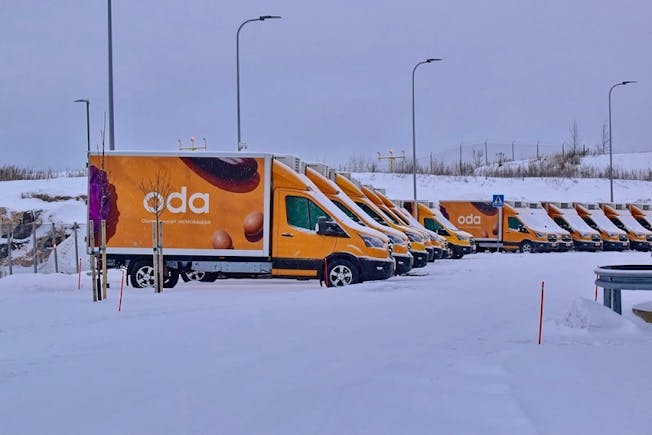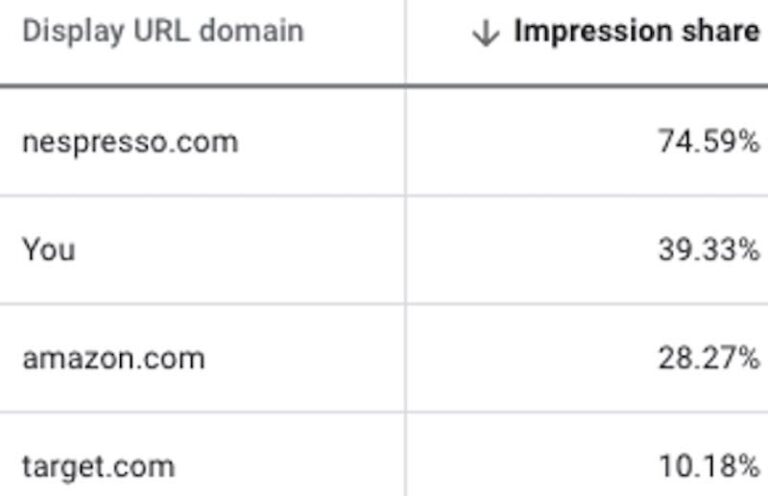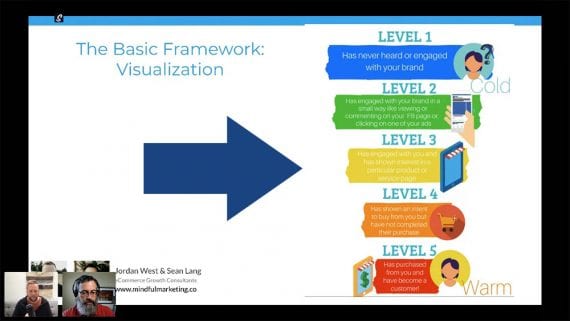Like Norway, Finland’s grocery market has relatively low online penetration, although its growth during the pandemic has still been significant; according to the Finnish Commerce Federation, online accounted for about 3% of grocery sales in December 2021, a share that has more than doubled since the start of 2020. Anne Terimo, commercial director at Oda, has reportedly attributed Finland’s low online penetration to high shipping costs: YLE News reported that Oda is hoping to undercut its major grocery rivals on delivery by offering free delivery on all orders over 40€.
The online grocery supply chain typically involves four components – suppliers, distribution centres, stores (or dark stores) and customers – with the picking and packing of online grocery orders taking place at stores or dark stores, ready to be delivered to or picked up by the customer. The so-called “last mile” of supply chain delivery from store or dark store to customer is notoriously expensive, and a great deal of time and effort has been poured over the years into thinking up ways to optimise it and cut down on costs.
When it comes to click-and-collect, however, Munthe-Kaas believes that “people would prefer home delivery – especially when you do it this efficiently … The difference in cost between pickup and home delivery [then] starts to become pretty small.” As for using stores to pick and pack orders, “you can do it in small areas and pockets and so on, but to really drive big volumes, there’s so much to gain from doing a separate value chain.”
There are trade-offs inherent in having a longer last mile of delivery; Oda is not in a position to offer its customers rapid delivery, or anything faster than same-day delivery with at least four hours between order and delivery; next-day delivery is ideal. Munthe-Kaas admitted that this is “definitely a compromise – but if the customer can accept that, then they get all the benefits of a massive assortment, great quality, and in fact discount prices.
“We’ve realised that online grocery can actually be done so much more efficiently than what people believe … so let’s use that knowledge and try to gain as much market share in as many countries as we can, and provide space for life, which is what we’re here for.”
With that said, there are also difficulties inherent in shrinking automation technology down to fit in an MFC; Ocado has admitted that its smallest MFC in west London is only “part automated”, and it is still working on developing a robotic platform that can operate in smaller spaces.
How to make online grocery competitive on price
Karl Munthe-Kaas, co-founder and CEO of Norwegian online supermarket Oda, is adamant that online grocery has the capability to compete with offline discounters on price – if executed in the right way.
“We are definitely an online grocer,” Munthe-Kaas confirmed. While the possibility of licensing out Oda’s technology has been discussed in the boardroom “many, many times”, it would go against the company’s beliefs that retailers are better off when they develop their own bespoke systems instead of buying off-the-shelf. “Our clients wouldn’t really be able to develop it further,” he said.
Speaking to Siobhan Gehin, Senior Partner, Retail & Consumer at Roland Berger during Day 2 of ShopTalk Europe, Munthe-Kaas said that “If you do online groceries right, and you do it efficiently, it can be more efficient as a value chain than offline – and even offline discounters.”
Ecommerce Quarterly: Q2 2022
UX features that discount retailers are using to drive ecommerce conversions
Exactly how Oda manages to achieve such high UPH levels is a closely-guarded company secret, but in an interview with TechCrunch last year Munthe-Kaas confirmed that “a lot of automation and data analytics” go into the process. At ShopTalk Europe, he explained that Oda hasn’t always had its hyper-efficient fulfilment system, “but we did know that we needed to build our own system to ever get there. And it took us several years – we also needed volume to run our automation the way it should run.”
In Munthe-Kaas’ view, grocery retailers don’t benefit from trying to combine online with offline – at least when pure online profitability is taken as a success metric. “If I owned the biggest offline retailer in Norway, and Oda, I would keep them entirely separate,” he said.
An “entirely new infrastructure” for grocery distribution
Even without divulging the tricks of his trade, however, Munthe-Kaas’ message to retailers in the audience was that “it’s possible; and if you realise that it’s possible to do with a fairly low-capex [capital expenditure] model – we’re talking 15 million Euros in capex per site – that is truly disruptive. We’re talking about an entirely new infrastructure for how we distribute groceries from producers to the end customer.”
“And we believe that that’s where you need to be to enter the mass market,” he went on. “If you’re a family living on budgets, you cannot pay 10% markup for the majority of your food.”
Arguably, automated micro-fulfilment centres (MFCs) are the exception to this rule, as they promise the best of both worlds: an MFC can be housed inside an existing store or in a smaller warehouse in an urban location, putting them closer to the consumer, while still enabling the cost savings that come with automation. This would also unlock the potential for an online pureplay like Oda to offer rapid delivery; Ocado, for example, is investing in MFCs to support its one-hour “Zoom” service, pledging to add to its two existing London sites in Acton and Canning Town.
This is particularly resonant amidst soaring prices and a mounting cost of living crisis. In early May, Sainsbury’s raised prices for its online delivery slots, while the Grocery Gazette noted that online grocery shopping was experiencing a “massive drop-off”, although it acknowledged that the lifting of restrictions made it difficult to determine whether consumers’ return to shopping in-store was solely due to inflation and the cost of living crisis. However, the publication quoted Kantar’s head of retail and consumer insight, Fraser McKevitt, who asserted that families with tight budgets were not the core audience for online grocery.
“Fundamentally, there isn’t really a reason – I think if you’re an established retailer, you can do what we have done,” Munthe-Kaas replied. “You just have to be very mindful of then creating a culture in that spin-off [business] that can work unencumbered. We have achieved these results because we have not made compromises – we have adapted our offering to what gives us an optimal value chain, and by extension, we have been able to be great on price, and that has clearly driven our market share.”

This means that the picking and packing of orders is all carried out in Oda’s massive distribution centres, which Munthe-Kaas estimated are equivalent to around 60 Norwegian supermarkets, and from there “we deliver to customers in a sequence”. Despite this elongated last mile, Munthe-Kaas emphasised that Oda can still achieve highly efficient delivery:
Siobhan Gehin probed Munthe-Kaas as to why established incumbents in Norway haven’t adopted the same distribution model for online, if it is so demonstrably effective. “How come it takes a startup to … bring this kind of new thinking on the value chain to the market?” she asked.
Oda was founded by a group of 10 co-founders, seven of whom had a background in technology, and three of whom had a background in operations. “We definitely came from the system side of things,” Munthe-Kaas said – something that helped when creating the unique value chain on which Oda is built (more on this in a moment). The business was originally called Kolonial, which is Norwegian for “corner shop”, and rebranded as Oda in 2021 after raising a round of funding to help it expand internationally.
What has enabled Oda to get to this point, when so many other grocers have struggled to turn a profit online due to the notoriously thin margins at play? Even Ocado, after delivering record sales in 2020 following nine months of pandemic-fuelled online shopping, still recorded a £44 million loss due to technology investments – and a year later warned its 2022 earnings would undershoot expectations. Meanwhile, amid a funding round last year for its planned international expansion to Finland and Germany, Oda announced that it was currently turning a profit. While this is not exactly an apples-to-apples comparison given that Ocado has already expanded internationally (and Oda’s figures may look different now that it has begun to launch overseas), Oda has achieved this while progressively lowering its prices. Furthermore, Munthe-Kaas’ claim is that Oda’s specific value chain and fulfilment system enable it to turn a profit and match discounters on price all while offering home delivery – which has long been the bane of retailers’ profit margins.
For omnichannel retailers, the store estate is generally seen as an asset to online profitability in allowing them to offer click-and-collect, which yields significantly better margins than home delivery: calculations by Bain & Co., published in 2020, put the profit margins for click-and-collect orders at -5 to 2%, depending on the fulfilment method, whereas home delivery fared much worse at -15 to -2%. Stores can also have greater proximity to consumers than massive, centralised warehouses due to their smaller footprint, thereby shrinking the last mile when they are used to pick and pack orders and enabling innovations like q-commerce.
Scale is important for the value chain that Munthe-Kaas says is the secret to Oda’s success at competing on price with offline discounters. He highlighted three figures that he says are key to enabling a pureplay online grocer like Oda to be competitive: more than 200 UPH (Units Per Hour, referring to the number of items picked per labour hour at a warehouse), more than five DPH (Drops Per Hour, referring to the number of deliveries per hour), and more than 100 euros in average order value. “If you’re able to achieve these numbers, then in fact online grocery can be more efficient than offline discount, which means you can then price it at online discount,” said Munthe-Kaas.
Are stores an asset in online grocery?
However, omnichannel retail has other benefits outside of the value chain; studies have indicated that omnichannel customers shop more often and spend more, and given that the bulk of grocery shopping is still carried out in stores, omnichannel retailers can potentially collect more purchase data across online and offline to inform strategic decisions or utilise in retail media networks. Omnichannel grocers would therefore no doubt argue that there is plenty to be gained from straddling online and offline – even if it presents a challenge to online profit margins.
Perhaps surprisingly, Oda’s solution to the “last mile problem” is not to bring stores or dark stores closer to customers but to omit this step altogether, bringing orders straight from the distribution centre to the customer.
Even so, Oda has already achieved its goal of price parity with offline discounters. As its efficiency and scale improve, it has been gradually inching down prices: last year it had a 3-4% gap with discount supermarkets in Norway (Munthe-Kaas did not specify which competitors Oda has been matching its prices against), which it has since managed to close, and has even beaten discount grocers on “several price tests”.
Oda’s Finnish rivals have welcomed the added competition, but K-Group’s director of ecommerce expressed scepticism about Oda’s budget pricing ambitions: “In no country do these players compete on the price of products.”
Other advantages of Oda’s model, he said, include fresher products and less waste, brought about by shortening the upstream value chain; meanwhile, its huge, centralised distribution centres allow Oda to offer a wider selection of goods. The company has also ensured that it is “unbeatable” on quality and has “invest[ed] a lot in the customer journey, both digitally, but also through customer service.”
He added that online grocery has historically been “mainly an upper-middle class phenomenon”, and that “to really penetrate the mass markets, we have to acknowledge that 80% of households do live on budgets.
In Oda’s home market of Norway, it will be interesting to see whether Oda’s affordability does succeed in changing perceptions of online grocery shopping as budget-unfriendly, and driving mass market adoption, as Munthe-Kaas believes it will. Nordic bank Nordea has predicted that due to low population density in Norway, online grocery penetration will be less than 15% in ten years’ time – “despite pure play online operator Kolonial [Oda] driving growth.”
This level of growth would still represent a significant increase in scale and profit for Oda and is nothing to be sniffed at, but it would be a far cry from mass adoption. Of course, a lot can take place over ten years, and the road to mass adoption would probably involve other online players bringing their prices down to become more competitive, or other low-price players opening up to serve the new customers entering the market; all of which is difficult to factor into predictions at this stage.
The international challenge and what’s next
Here’s how Munthe-Kaas believes that online grocery can compete with discount supermarkets on price, why he thinks that pureplay online grocers have an advantage over omnichannel grocers, and what Norway’s dominant online grocer has planned for the future.
Founded in 2013, Oda is a pureplay online grocer that currently has more than 70% market share of online grocery in Norway, and recently set its sights on expanding overseas. It has spent years refining a supply chain and fulfilment system that lets it compete on price with offline discount supermarkets, and which Munthe-Kaas says would allow online grocery – which in Norway is estimated to have had just 1% penetration prior to the pandemic – to achieve mass market penetration.
Oda’s price parity with offline discounters was also an achievement several years in the making, and Munthe-Kaas acknowledged that in Norway, its price perception is still “tracking behind” actual prices: “When we came in[to] market, early on, we were a premium player like everyone else; we didn’t have the sourcing terms, we didn’t have the systems yet. So it’s been a gradual journey, which means we’re still, unfortunately, tracking behind – our prices are lower than our perception.” Oda will be facing this battle all over again in a new market – but Munthe-Kaas sees the situation as an opportunity: “When you think about it differently, that means that that’s going to be a continuous source of new growth, as customers realise [we’re] actually as cheap as, or cheaper than, discounters.”
“If online is ever to become the infrastructure that we know it has the potential to be, we need to get the price level down to match discounters – so that the home delivery convenience is an added benefit.”
“Currently, we operate in Norway; it’s not the most densely-populated country in the world, yet we do about three-minute average driving time between customers. … For this value chain to be efficient, obviously, these two big steps – fulfilment and distribution – need to be at absolute world-class levels, and that’s where the 200 UPH comes in.”
“For online groceries to truly be disruptive, we need to beat physical players on price, on quality, and on selection – the traditional parameters of offline retail,” he summarised. “And then the convenience of home delivery – that’s what’s going to drive growth.”
The next step for Oda is overseas expansion; following a successful round of funding in 2021, Oda launched in Finland last February, and is planning a launch in Germany in the autumn. This could be the true test of Oda’s model: it has spent the past nine years in Norway building brand equity and optimising its processes to make lower prices possible, but can it do the same abroad? Even though Oda’s launches in Finland and Germany will benefit from the tech development already carried out in Norway, as Munthe-Kaas said himself, the system needs volume in order to operate the way it should – and it will take time to build that up.
The rebrand was motivated in part by this international expansion, since the name “Kolonial” has quite different connotations outside of Norway, something that Oda wanted to avoid. Oda’s scope and ambitions in 2022 are also far beyond the humble corner shop: its primary competitors are Norway’s large incumbent supermarkets, and the average value of an order on Oda is 119€.
Oda succeeded in passing 200 UPH in 2020 (Munthe-Kaas offered slightly tongue-in-cheek congratulations to Ocado, its counterpart in the UK, for passing the same milestone in its most recent quarterly report), and its average order value is already well above 100€. The only metric Oda has yet to push up to the desired level is DPH, which Munthe-Kaas admits is “not quite there yet – but we’re getting there rapidly.”
Given the amount of time and effort that Oda has poured into developing its “world-class” automation and fulfilment system, Gehin asked Munthe-Kaas if there are any plans for Oda to license out its technology to other retailers, in the same vein as the Ocado Smart Platform. “Are you a grocer, are you a tech company?” she asked.




![Amazon Creative Strategies [2021 Guide]](https://research-institute.org/wp-content/uploads/2021/04/what-to-know-before-you-sell-your-small-business-768x432.png)

